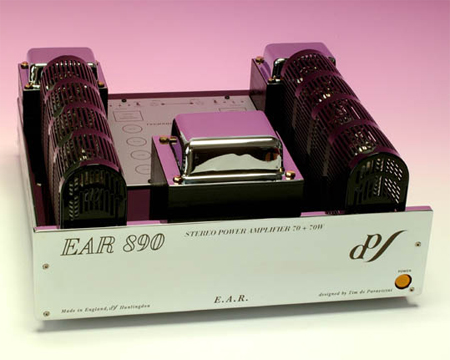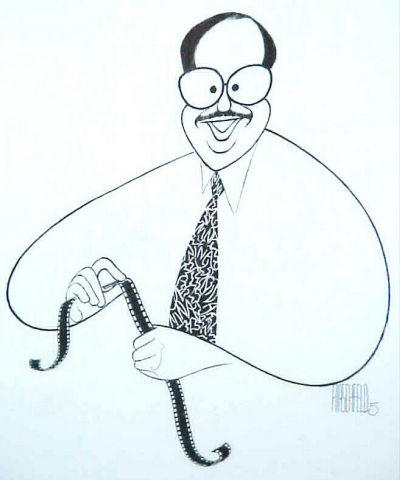
You are reading the older HTML site
Positive Feedback
ISSUE
27
e.a.r.
890 amplifiers
as reviewed by Robert H. Levi

|
Back in Issue 9, I reviewed the E.A.R. 890, a $5600 KT-90-tubed wonder amplifier, and bought the review sample. It has been working flawlessly in my system, powering my inefficient Avalon Eidolons with musical aplomb. Challenged by everything from Cary SET powerhouses to digital exotica from Edge, the 890 has not yet been bested. Even the superb NuForce 9SE amplifiers and the new Pass designs edged it out only in slam and ultra-deep bass definition.
The 890 remains the best-kept secret in vacuum tube amplification, and I believe this is because of its very conservative output rating. Though E.A.R. only claims 70 watts per channel, independent research has revealed that it easily does 80 watts RMS in 100 percent class A, and achieves peaks of 100 watts with ease, into 4- or 8-ohm loads. The dynamics of four self-biased KT-90s in class A tetrode push/pull mode per channel are fulfilling, musical, and very exciting. The trick here is the 890's natural definition, airy textures, and a neutrality that is trend-setting for tube amplifiers at any price. You can clearly hear through this amplifier, easily identifying cable colorations, source components, software nuances, and the like. I know of no other tube amplifier that is as neutral as the 890, an amplifier that gets out of the way and lets you enjoy the music.
Here's where this get interesting. The 890 is the most powerful stereo amplifier that Tim de Paravicini has made, and he is not currently offering monoblocks that put out more than 100 watts per channel. However, the 890 is bridgeable, resulting in a pair of monoblocks offering more than 160 class-A watts of tube power per channel, and unclippable at ear-shattering levels on a pair of 87dB-sensitive Avalon Eidolons. The stereo 890 becomes a monoblock with the click of two outboard switches and the connection of an external strap, which should be a 24-inch length of speaker wire identical to your normal speaker cables. There is no need for further adjustment.
Next comes listening. At $11,200 the pair, the 890 monoblocks will equal or exceed the performance of any tube amps I've heard, many of them upwards of $30,000. You read it right! In my opinion, they are not only the best-sounding E.A.R. amps, but they are as correct-sounding, ultra-defined, airy, neutral, and revealing as any of the efforts of VTL or ARC to date. Maybe it's the KT-90 tubes selected and tested by E.A.R. Maybe it's the transformers, designed by the master. Maybe it's the fact they run in 100 percent class A to the last watt. Maybe it's the fact that the circuit appears to be laden with fewer parts and fewer driver tubes. Just listen and you'll know. These are THE amplifiers to own and revel in, and they are a true bargain compared to some of the exotic amps made by highly regarded audiophile companies.
The mono 890s excel in high-band air, definition, and ambience. The highs are delicate and smooth, fast and clear. You won't detect any sweet tubiness, just a natural clarity revealing the utmost in natural definition. If your front end is up to it, and you're using fantastic interconnects, speaker cables, and AC cables like the Kubala-Sosna Emotions, you'll hear astounding high-end performance.
The mids are trend setting, and unsurpassed. Spend as much as you like. Try twenty 6550 tubes per channel, but you won't get better midrange. My Cary 300B SET amps are as revealing, but they only produce eight watts per channelónot much good with Avalons. The 890 monoblocks achieve SET-like definition along with the authority and swagger necessary for most full-size speaker systems. Because of the immense power reserves (though again, the transformers are partly responsible), I hear more definition with the monoblocks than I heard with the stereo 890. This is very unusual in my experience, but obviously not impossible, because Tim de Paravicini has done it. With gigantic soundstaging, scary depth, oodles of charming texture, and reach-out-and-touch-it definition and imaging, the 890 monoblocks are winners for the audiophile of means. The neutrality of this amazing design enhances the best sources, particularly live recordings.
The bass of the mono 890s is absolutely superb. It is surpassed in speed and power by the best solid-state amps, but only to a small degree, and it is the equal of any tube amplifier I've heard. The 890s' bass is very, very detailed and realistic. The amps are excellent with the 11-inch woofers in my Avalons, and should be superb on any other real-world speakers. The lovely continuity between the Avalon drivers is well preserved, and the sense of aliveness with all instruments, including the human voice, is magnificent. With the fantastic Metronome T2Ai and E.A.R. Acute CD players, the 890s' yielded bass authority I thought could only be achieved with transistors. The 890 monoblocks are as good as tubes get on the bottom octaves.
Are the 890 monoblocks the equal of the 600-watt Audio Research giants? I have not compared them directly, but I have experienced the ARC 600 and 210-watters in other systems, and did not hear any more clarity or definition on familiar source material. In fact, the ARC amps were not as transparent or neutral as the 890s. This may not be scientific, but it is true. The newest VTL designs, though excellent, sound a bit dynamically constrained compared to the 890s, and exhibit no more detail. These amplifiers cost between $15,000 and $35,000, but I would be hard pressed to recommend them over the 890 monoblocks for any reason, especially at $11,200. The 890s are as textured as the top Lamm designs, but with noticeably better neutrality and more power.
At more than 160 pure class-A watts per channel, the E.A.R. 890 monoblocks (two bridged 80-watt stereo amplifiers) take their place among the finest-sounding, cost-no-object amplifiers in the world. They refuse to clip or distort into the toughest loads. Their swagger and definition are incredibly involving and realistic. A pair of 890s is only underpriced compared to ARC, VTL, and Lamm's best designs, but they equal them in the most important audiophile musical parameters. They are unsurpassed in tonal accuracy and neutrality. If you need the best in amplification and are tired of compromising, the E.A.R. 890 monoblocks from the hand of designer Tim de Paravicini are the way to go. I'm buying a second 890. The mono 890s receive my highest high-powered tube amplifier recommendation, and clearly raise the bar for the state of the art. Robert H. Levi
Discs used in this review included:
-
Joe McQueen and Friends (Kimber Isomike SACD 55802)
-
The Turtle Creek Chorale, Testament (Reference Recordings RR49CD)
-
Symphonic Dances (Reference Recordings RR105)
-
Tchaikovsky, Trio for Piano, Violin, and Violoncello in A minor (Mirrored Nature MNR 5001)
-
The Carl Saunders Sextet (BluePort BP-J011)
-
Gene Harris, The Best of the Concord Years (Concord Records 4930-2)
-
Hovhaness, Symphony 22/Cello Concerto (Naxos 8.559158)
-
Jacintha, Here's to Ben (Groove Note 1001-3)
-
Chopin, Piano Concertos 1&2, Rubinstein (RCA/BMG 82876-67902-2)
-
Piatigorsky/Dvorak, Cello Concertos (RCA/BMG 82876-66375-2)
-
Suppe, Overtures (Mercury Living Presence 470-638-2)
-
Hovhaness, Mysterious Mountain (Telarc 60604)
-
Eric Darius, Just Getting Started (EMI/Narada 724386055620)
-
Miles Davis, Kind of Blue (Columbia 90887)
-
Turtle Island String Quartet (Telarc 60630)
-
The Absolute Sound SACD Sampler (Telarc 60011)
-
Howard Hanson, Symphony No.2 (Telarc 60649)
-
Stravinsky, Firebird Suite, Jarvi (Telarc 60587)
-
SuperBass2 (Telarc 63483)
-
Orff, Carmina Buran (Telarc 60575)
-
Diana Krall, Love Scenes (Impulse 2841-35)
-
A Song for You (FIM 036)
-
Duke Ellington, Blues in Orbit (Mobile Fidelity 757)
-
Isomike Sampler (Kimber 2005A)
-
Chick Corea, Rendezvous in NY (Stretch 9041-2)
-
Saint-Saens, Piano Concertos Vol. 1 (Audite 92.509)
-
Schumann/Lalo/Saint-Saens, Cello Concertos, Starker (Mercury 4756621)
-
Berlioz, Symphony Fantastique, Paray, Detroit Symphony (Mercury 4756622)
-
Tchaikovsky, The Nutcracker, Dorati, London Symphony (Mercury 4756623)
-
Gershwin, An American in Paris, Dorati (Mercury 4343292)
890 amplifier
Retail: $5600 each
E.A.R. Yoshino
web address:
www.ear-yoshino.com
E.A.R. USA
web address: www.ear-usa.com

